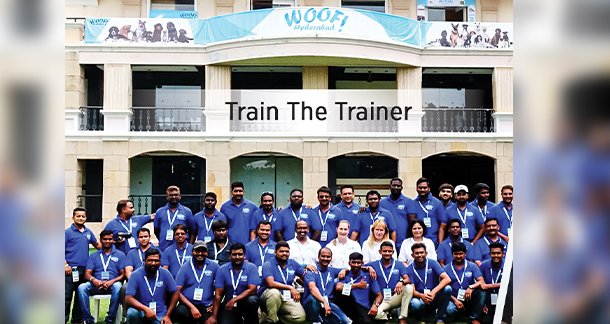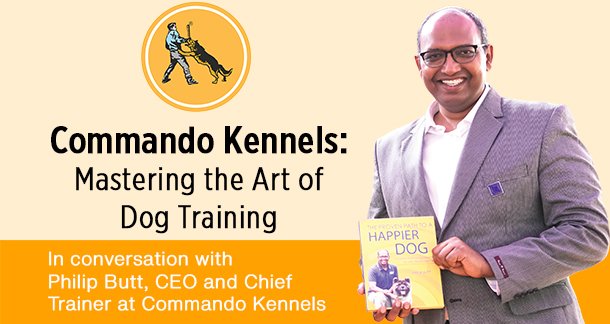In conversation with Philip Butt, CEO and Chief Trainer at Commando Kennels, with over 30 years in the pet industry. He serves as President of the Obedience and Agility Club (affiliated with the Kennel Club of India), Honorary Secretary of the Hyderabad Canine Club, and Show Secretary of the HyCan Dog Show. He’s also the brain behind Petex and HyPet – pet industry expos, dedicated to elevating pet care and services in India.

Question- With over 30 years of experience as a trainer and mentor, what inspired you to start this journey, and how do you see the field has changed since then?
My father started Commando Kennels in 1986, so next year marks 40 years. As a child, I grew up watching him train dogs and win competitions, which deeply inspired me. Although I studied hotel management, after college, my father and I decided to shift out of the city and scale the business. Today, we care for over 300 dogs at our facility, a decision I’m very proud of.
Over the past three decades, the pet industry has evolved significantly. Earlier, dogs were mostly fed home-cooked meals; today, there’s tremendous advancement in nutrition, grooming, and healthcare. Back then, big breeds like German Shepherds and Rottweilers were popular. Now, India has a diverse mix of breeds.
However, dog training as a field hasn’t progressed as much. That’s my mission, to modernize it. While there’s increasing demand, especially in security and detection with government support, there’s still no structured learning path. Most trainers still follow outdated, correction-based methods, especially for working dogs due to lack of awareness and formal education.
Having transitioned from correction-based to force-free training myself, I’ve seen firsthand how positive reinforcement leads to happier, healthier, and more effective dogs. Change is happening, but we still have a long way to go.
Question– What is the difference between correction-based training and force free training?
Force-free training isn’t just better for the dog, it’s also more effective and commercially viable. In our canine security business, we have over 250 dogs deployed across India. Since transitioning to positive reinforcement, our dogs’ working lifespan has nearly doubled from 4–5 years to 8–10 years. Improved nutrition plays a role, but reducing stress through humane training is key.
Stress-based training elevates cortisol levels, shortening a dog’s lifespan and impacting health. We used to regularly face issues like skin conditions and early mortality in our kennel. Now, with force-free methods, our big breeds live up to 14–15 years, and medication needs have drastically reduced.
So, beyond ethics and effectiveness, from a business perspective too, force-free training results in healthier dogs, longer service lives, and better performance.

Question– You’ve introduced dog sports like flyball and others to India. What was the motivation behind this, and how do these sports support the professional growth of trainers, breeders, and kennel owners?
One of our key efforts has been to introduce dog sports like Flyball, Agility, Schutzhund, and IPO in India to show what’s possible with a trained dog. Years ago, the idea of a dog was limited to it barking at the gate. But today’s generation, particularly those in their 20s and 30s truly invests in their pets. They’re stepping out, training their dogs, attending dog parks, and participating in events. The focus has shifted from fixing problems to enriching a dog’s life. This evolution is deeply gratifying because it means dogs are finally getting the fulfilled, active lives they deserve.
When it comes to training, the handler’s temperament is crucial. While most dog trainers love dogs, love alone isn’t enough. Without education in force-free methods and positive reinforcement, many unintentionally rely on correction-based techniques. I’ve observed a worrying progression, from wanting control to deriving satisfaction from corrections. To prevent this, trainers and pet parents must invest in learning modern, humane methods. True transformation comes not just from good intentions but from the knowledge of how to train without harm.

Question– You’ve trained and deployed dogs across countries like India, Sri Lanka, Afghanistan, Italy, and Malaysia. When deploying them, do you send handlers along or conduct handler training on-site?
We typically train handlers on-site, whether it’s in India or abroad. For instance, in our ongoing project with Malaysian Customs, we’ve trained 30 canine officers over two years to work with the trained dogs we supplied. Interestingly, when working with departments like the Indian Forest Service, I actually prefer untrained handlers. If someone is a dog lover but hasn’t been exposed to outdated training methods, it’s easier to teach them force-free techniques. In contrast, experienced handlers often struggle to unlearn habits, even when they genuinely want to change.
This challenge isn’t unique to India, it’s global. Trainers with 15–20 years of experience often resist switching to new, humane training methods because traditional practices are deeply ingrained. We went through this ourselves; even after learning force-free techniques from international experts, it took nearly three years to eliminate the last choke chain from our kennel. The team wanted to change, but habits die hard. Fortunately, dogs everywhere respond to the same positive methods so when the handler is open and trained well, the transformation is always possible.
Question– Is it harder to train Indian street dogs (Indies) compared to pedigree breeds? What are the challenges and misconceptions around this?
A: Training Indian Street dogs can present unique challenges, but it’s important to understand that the difficulty isn’t rooted in their genetics, it’s in their early life experiences. Many Indies are born on the streets without early human interaction, which can lead to wariness or fear-based behaviors. In contrast, most pedigree puppies are raised in homes or kennels where they get handled early, helping them adjust to people and routines more easily. It’s a socialization gap, not a capability issue.
Another factor is predictability. Purebred dogs have been selectively bred for generations to display specific traits like affection in Labradors or alertness in German Shepherds, making their training needs and personalities easier to anticipate. Indies, however, are mostly ‘hounds‘ with a mix of temperaments and instincts, often resulting in a broader behavioral spectrum. That unpredictability sometimes clashes with pet parents’ expectations. Many people mistakenly expect an Indy to behave like a Golden Retriever, which is not only unfair but also sets the dog up for failure. Understanding and working with their individuality is key.

Question- What inspired you to start the Grooming Academy, and how does it fit into your larger vision for India’s pet care ecosystem?
A: The Academy of Grooming Arts is rooted in a simple but powerful belief—that India has the potential not just to match global standards in pet care services, but to lead. While we’ve made great strides in product innovation, services still lag behind. I’ve always seen three pillars that need focused development: training, grooming, and veterinary care. While the science of veterinary medicine is steadily evolving in India, the “care” component, especially grooming and training, requires a more structured and professional approach. That’s where the academy comes in. It’s not just about teaching how to clip nails or bathe a dog—it’s about creating skilled professionals who understand animal behavior, safety, and hygiene at a deep level.
Our model breaks away from the traditional short-term, one-off workshops often led by international trainers with little follow-up. I believe real learning happens through mentorship and hands-on experience. That’s why we offer longer courses or capsule formats that build on each other, allowing learners to gradually absorb, practice, and master their skills. We also deliberately cross-train—teaching groomers basic training principles and vice versa—because the more well-rounded a pet professional is, the better they can serve both pets and pet parents. Ultimately, it’s about building careers, not just offering courses.

